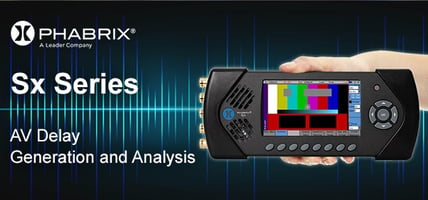Although SDI feeds hold both video and audio data, this does not mean that the video and audio are...
Unravelling the Mysteries of AV Delay: A Deep Dive into Audio-Visual Synchronization
In the world of broadcast engineering, achieving seamless audio-visual synchronization is paramount for delivering an immersive and enjoyable viewing experience. One of the key challenges faced by broadcast professionals is the phenomenon known as AV delay, where the audio and video signals experience a noticeable time difference. In this blog post, we will explore the intricacies of AV delay, its causes, and the strategies employed by broadcast engineers to mitigate its impact.
Understanding AV Delay:
AV delay, also referred to as lip sync error, occurs when the time it takes for an audio signal to reach the audience's ears differs from the time it takes for the corresponding video signal to reach their eyes. This misalignment can result in a jarring viewing experience, negatively impacting the overall quality of the content.
Causes of AV Delay:
- Signal Processing: The processing of audio and video signals involves various stages, including encoding, decoding, and transmission. Each of these stages introduces some level of delay. For example, compression algorithms used in video encoding can add latency.
- Equipment Latency: Different types of audio and video equipment, such as cameras, microphones, and displays, may have inherent latency. This latency can accumulate as signals pass through multiple devices in the production and transmission chain.
- Transmission Medium: The method used to transmit audio and video signals also contributes to AV delay. For instance, broadcasting over satellite, fiber optics, or the internet can introduce varying degrees of latency.
- Human Factors: The perception of AV sync can be influenced by individual differences in how people process sensory information. Factors such as hearing impairments or visual acuity can impact a viewer's sensitivity to AV delay.
Mitigating AV Delay:
- Buffering: Introducing controlled buffering at various points in the signal chain can help compensate for latency introduced during processing and transmission. However, excessive buffering can lead to other issues, such as increased overall system delay.
- Advanced Signal Processing: Implementing sophisticated signal processing algorithms, including real-time synchronization techniques, can help minimize delay. This involves analyzing the audio and video signals in real-time and dynamically adjusting them to maintain synchronization.
- Precision Timing: Using precision timing references throughout the production and transmission process helps ensure that all devices and components are synchronized. This can involve the use of specialized clocks and synchronization protocols.
- Monitoring and Calibration: Regular monitoring and calibration of equipment are crucial for identifying and addressing sources of delay. This includes the use of dedicated monitoring systems to detect and correct any deviations in AV synchronization.
Conclusion:
In the dynamic landscape of broadcast engineering, achieving perfect audio-visual synchronization remains a complex challenge. As technology continues to evolve, so too do the tools and techniques employed by professionals to mitigate the impact of AV delay. By understanding the causes and implementing effective strategies, broadcast engineers can continue to push the boundaries of audio-visual excellence, ensuring that viewers receive a seamless and immersive entertainment experience.
Find out how our AV Delay option, available on the Sx Series of handheld instruments and Rx Series of 2K/3G/SD/HD rasterizers offers an end-to-end solution for the measurement of audio to video differential delay through a broadcast chain.





